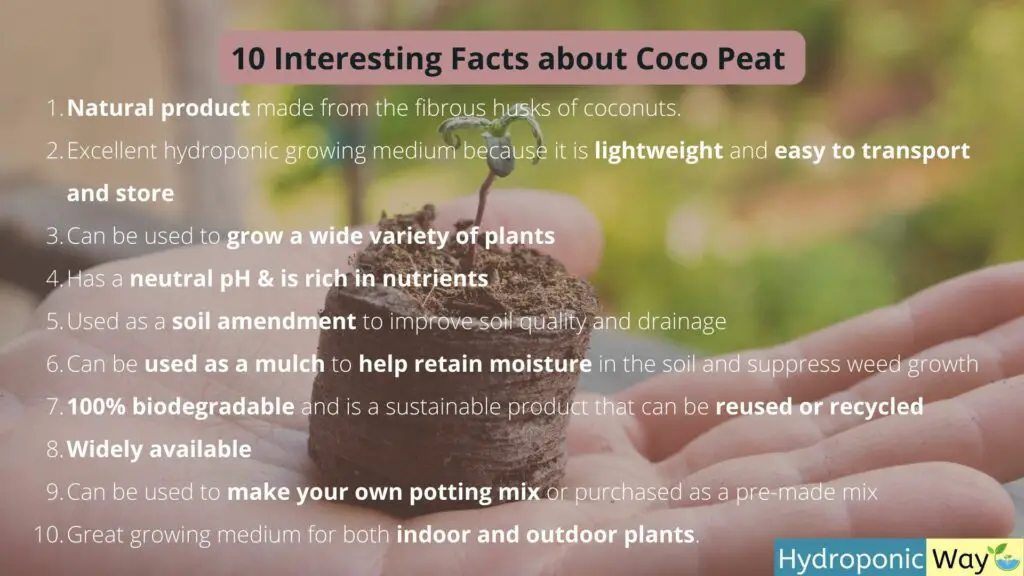10 Interesting Facts About the Use of Cocopeat in Hydroponics (The best growing Medium).
Hydroponics doesn’t require a growing medium. But having one has some advantages. Cocopeat is a perfect and popular option. Here are some interesting facts about cocopeat in hydroponics.
This blog post will discuss ten interesting facts about coco peat that may convince you to give it a try!
Disclosure: Your purchases through our links may earn us a small commission, supporting our site’s ability to provide valuable information to our readers. Rest assured, it won’t impact your price. Thank you for your support.
- Coco peat is a natural product made from the fibrous husks of coconuts. Cocopeat is made from the husks of coconuts that have been ground into a fine powder. The powder is then mixed with water and formed into small pellets. The pellets are then dried in the sun or a kiln. It is an environmentally friendly alternative to peat moss, which is a non-renewable resource.
- Coco peat is an excellent hydroponic growing medium because it is lightweight and easy to transport and store. It is also absorbent, so it helps to keep plants moist. And it is sterile so that it won’t harbor harmful bacteria or fungi. It is less likely to become contaminated.
- Coco peat can be used to grow a wide variety of plants, including flowers such as roses, orchids, and carnations; vegetables such as tomatoes, cucumbers, and peppers; and fruit such as strawberries and watermelons.
- Coco peat has a neutral pH and is rich in nutrients, making it an ideal growing medium for seedlings and young plants. Because you do not need to add any additional nutrients or add fewer nutrients to the system, the plants will be able to extract all of the nutrients they need from the growing medium. Learn more on NPK for hydroponics: how it works and why it matters?
- Coco peat is also used as a soil amendment to improve soil quality and drainage. The addition of cocopeat to soil can be very beneficial as it is a natural product made from the husks of coconuts. It is a lightweight, spongy material that holds water and air well. Coco peat can help improve soil structure, drainage, and aeration. It also helps to retain moisture and nutrients in the soil. All of these benefits can help to enhance plant growth and yield.
- Coco peat can be used as a mulch to help retain moisture in the soil and suppress weed growth. It is made from the coconut husks left over after the coconuts have been processed for their meat and oil. Coco peat is high in organic matter, so it breaks down slowly and helps improve the quality of your soil over time. It also reduces water evaporation from the soil, so your plants will get the moisture they need even during hot, dry weather.
Also, learn how to use rice hulls as mulch in hydroponics?
- Coco peat is 100% biodegradable and is a sustainable product that can be reused or recycled. The benefits of these are protecting your family and pets from harmful chemicals, helping the environment by reducing waste, doing your part to reduce pollution, and living more sustainably.
Related:
9 Useful Tips to Create a Sustainable Hydroponics for Long Term Success
Can We Grow Certified Organic Hydroponic Plants?
11 Different Biodegradable Resources You Can Use for Hydroponics - Coco peat is widely available and is sold a blocks or bricks, plugs or coins and bags or bales, making it easy to transport and store.
- Coco peat can be used to make your own potting mix or purchased as a pre-made mix. You can customize the mix to suit your individual needs. For example, if you have plants that require a lot of water, you can add more water-retaining ingredients to the mix. Alternatively, if you have plants that need very well-drained soil, you can add more drainage-enhancing ingredients. Purchasing a pre-made mix can also be convenient, but it may not be tailored to your specific gardening needs. Therefore, read the product descriptions carefully.
- Coco peat is an great growing medium for both indoor and outdoor plants. When you grow indoor plants in coco peat, you will need to water them more frequently than plants grown in other types of potting mix. If you are growing outdoor plants in coco peat, you will need to water them less often than growing them in soil. This is because coco peat retains moisture better than soil.
If you are looking to buy coco peat for your indoor or outdoor garden click this link to select the best one suited for you.
Many gardeners, especially beginners, confuse coco peat with coco coir and peat moss. Also, you may need to learn the differences between some other growing mediums. We are here to help. Read our previous posts listed below on these topics.
Coco Peat vs Coco Coir: What’s the Difference?
Peat Moss vs. Coco Coir: The Ultimate Showdown
Rockwool vs Coco Coir: Which Is the Right Choice for You?
Coco Peat vs. Peat Moss: What’s the Difference?
Do you wonder why oxygen is important in hydroponic systems! Read the linked post to learn more.

Thank you for reading!
Related:
How to Use Coco Peat to Grow Plants and for Seed Germination?
How to Grow Hydroponic Plants with Coco Coir?
10 Characteristics of Ideal Hydroponic Growing Medium






